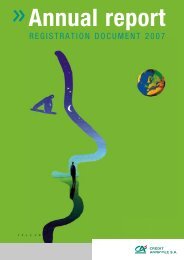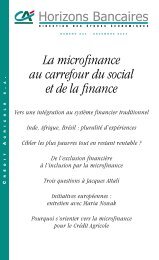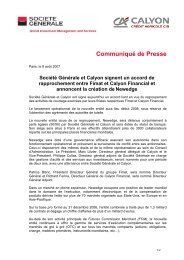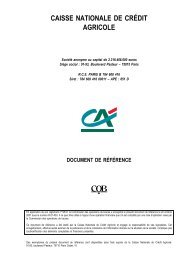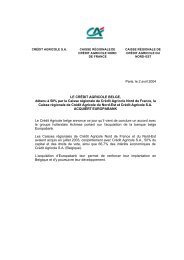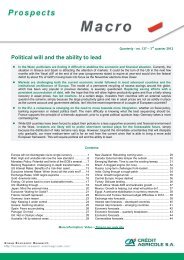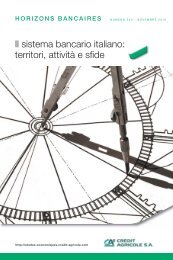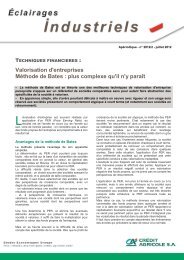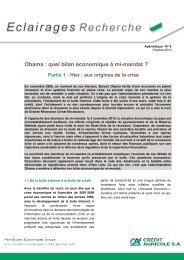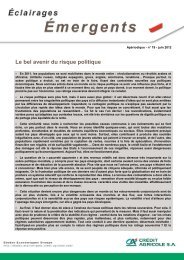PDF (3.77 Mo) - Le Crédit Agricole
PDF (3.77 Mo) - Le Crédit Agricole
PDF (3.77 Mo) - Le Crédit Agricole
Create successful ePaper yourself
Turn your PDF publications into a flip-book with our unique Google optimized e-Paper software.
Crédit <strong>Agricole</strong> S.A.Update of the 2011 registration document - A03Recent trends and outlookRecent eventsRecent events subsequent to the closing date are reported in note 9 of the appendices of the interimcondensed financial statements at 30 June 2012.Outlook for the second half of 2012The decisions made during the EU summit in late June paved the way for further action by the ECB. On 5July, it further cut its key rates – the refinancing rate to 0.75% and the deposit facility to zero – and extendedthe eligibility criteria for collateral in order to ensure at all costs refinancing for banks excluded from thewholesale liquidity market.With every breach that closes, another one opens. While banking risk in Spain appears to have beencontained, investors are now worried about the sustainability of Spain’s public finances, particularly those ofthe autonomous regions that have no choice but to ask for central government aid to meet their financialcommitments. This then gives rise to doubts concerning the capacity of EU firewalls, considering their limitedsize, to cope with the challenge of bailing out one or several major eurozone states. This fear was furtherconveyed by <strong>Mo</strong>ody’s, which decided in late July to put the sovereign ratings of Europe’s creditor states,including Germany, on negative watch.The ECB is currently the only institution with sufficient ammunition to block contagion. In the short term, itshould show more flexibility, agreeing to reactivate its Securities Market Programme (SMP) and/or opting foranother long-term refinancing operation (LTRO) to stabilise market expectations and relax global financialconditions. In any case, we expect a final rate cut in September.Economic statistics released over the summer give a bleak picture of the economic situation. Eurozone GDPfell by 0.2% in the second quarter, with a persistent gap between central countries, which almost seem to bemarking time (Germany +0.3%, France 0.0%), and southern countries, which are failing to find their way outof recession (Spain -0.4%, Italy -0.7% and Portugal -1.2%). Survey data remain unfavourable, with recoveryin the eurozone looking set to be laborious, still curbed by fiscal austerity. In the United States, recentindicators point towards weakening of the economic climate. The acute question therefore arises ofconsolidating the country’s public finances, a challenge that will have to be tackled by the new Presidentelected in November. In order to accommodate the cycle, the Fed may decide in September to introduceanother round of quantitative easing (QE3).This very accommodating policy is likely to curb the rise in the dollar, with a target of 1.26 against the euro atthe end of the year. The implementation of the European Stability Mechanism, aggressive action by theECB, the gradual application of agreements reached during the EU summit in late June and steps towardsgreater EU integration (firstly in banking, then fiscal and political) could help to calm the markets. The returnof risk appetite – even to a limited extent - is likely to result in an upward trend in bond yields for the topquality sovereign issuers (1.75% for the German bund in December) and the gradual deflation of riskpremiums for countries with weak finances.Page 108 sur 237



